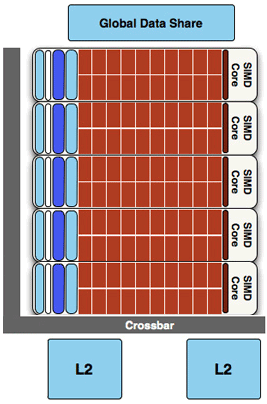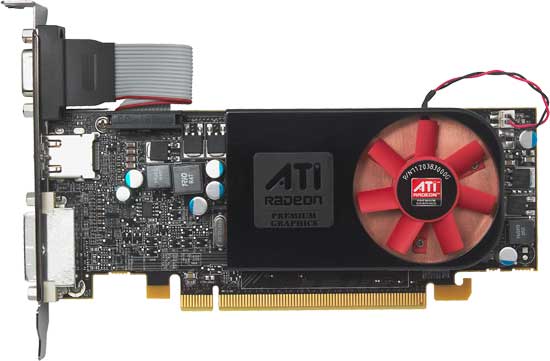AMD’s Radeon HD 5570: Low Profile, Higher Performance
by Ryan Smith on February 9, 2010 12:00 AM EST- Posted in
- GPUs
When AMD launched the 5670, they told us they had 2 more cards on the way: the 5450, and a 5500 series card. Last week we saw the launch of the 5450, utilizing the Cedar GPU and finishing off AMD’s chip stack. Today we’re looking at that 5500 series card, the Radeon HD 5570.
| AMD Radeon HD 5670 | AMD Radeon HD 5570 | AMD Radeon HD 4670 | AMD Radeon HD 5450 | AMD Radeon HD 4550 | |
| Stream Processors | 400 | 400 | 320 | 80 | 80 |
| Texture Units | 20 | 20 | 32 | 8 | 8 |
| ROPs | 8 | 8 | 8 | 4 | 4 |
| Core Clock | 775MHz | 650 | 750MHz | 650MHz | 650MHz |
| Memory Clock | 1000MHz (4000MHz data rate) GDDR5 | 900MHz (1800MHz data rate) DDR3 | 1000MHz (2000MHz data rate) GDDR3 | 800MHz (1600MHz data rate) DDR3 | 800MHz (1600MHz data rate) DDR3 |
| Memory Bus Width | 128-bit | 128-bit | 128-bit | 64-bit | 64-bit |
| Frame Buffer | 1GB / 512MB | 1GB | 1GB / 512MB | 1GB / 512MB | 1GB / 512MB |
| Transistor Count | 627M | 627M | 514M | 292M | 242M |
| TDP | 61W | 42.7W | 59W | 19.1W | 25W |
| Manufacturing Process | TSMC 40nm | TSMC 40nm | TSMC 55nm | TSMC 40nm | TSMC 55nm |
| Price Point | $99 / $119 | $80-$85 | $60-$90 | $49-$59 | $35-$55 |
Right off the bat, the 5570 marks a bit of a departure from AMD’s numbering scheme for the 4000 series. While the Radeon HD 4550 was the faster of the two cards utilizing AMD’s cheapest GPU (RV710), the 5570 is not a faster Cedar card. Instead it’s a slower Redwood card, putting it in the ballpark of the 5670’s rather than the 5450’s.

AMD has done 3 things to differentiate the 5570 from the 5670. The first of which is to significantly castrate the 5670’s memory bandwidth. While the 5670 had 1GHz (4GHz effective) GDD5, the 5570 drops that for simple 900MHz (1.8GHz effective) DDR3, giving the card only 45% of the memory bandwidth of the 5670. The second change is more customary, and that is lowering the core clock from 775MHz to 650MHz, leaving the card with roughly 83% of the computational/rendering/texturing performance of the 5670. None of the SIMDs have been disabled however, so this is a fully functional Redwood GPU.

Finally, in another significant departure from the 4000 series, this is AMD’s second official low-profile video card. For the 4000 series AMD’s only official low-profile card was the 4350, although vendors were known to do low-profile versions of the 4550 (RV710) and the 4650 (RV730). Here AMD is not leaving that up to their vendors, and is doing an official retail low-profile design for their more powerful Redwood GPU. This allows AMD to fill a potential hole in their lineup by offering a low-profile GPU with better than bargain-bin performance.
This card also fills the overall price/performance hole in AMD’s 5000 series lineup, giving them something between the $9 9 5670 and the $50-$60 5450. AMD’s MSRP on this card will be $85, a bit more than half way between the other two cards. Unlike the 5670 and 5450, we’ll only be seeing a single official configuration of the 5570: 1GB of 900MHz DDR3. Our sample comes with 900MHz Samsung chips. It’s also worth noting that this is the same memory configuration as the base Radeon HD 4670, which also used 1GB of 900MHz DDR3.
Between the drop in the core clock and the movement to DDR3, AMD has lopped off nearly 30W from the 5670’s load power usage, bringing the 5570 in at 42.7W. Idle power also drops by nearly 33%, for 9.7W. This low power usage is a big part of why AMD can get away with the 5570 being a low-profile card, as they only need a small single-slot blower to cool the card. The reference cooler (not that we expect many – if any – vendors to use it) is a blower design built upon a copper heatsink, with a small fan blowing air towards the front of the card.

The port configuration is the same as the 5450: 1 VGA, 1 DVI, and 1 smaller digital port. Our sample came with a HDMI port, with vendors free to use an HDMI port or a DisplayPort depending on whether they want Eyefinity support as enabled by using a DisplayPort. As has been the case with all of AMD’s sub-$100 5000 series cards, Eyefinity is still cost-prohibitive at this time due to a lack of cheap active DisplayPort adaptors and monitors offering DisplayPort inputs.
AMD considers NVIDIA’s GT 220 the chief competition for this card. The GT 220 isn’t an official low-profile card, but there are a few models out there in that form factor. In terms of overall pricing, a number of GDDR5 GT 240s can be found at or right below $85, making the GT 240 the closest competitor for this card.










36 Comments
View All Comments
andy o - Tuesday, February 9, 2010 - link
I think you mean "when ESVP is enabled" here:"it looks like AMD is hardcoding their drivers to disable certain post-processing features when ESVP is disabled"
andy o - Tuesday, February 9, 2010 - link
Ryan, I don't think this is such a big deal:"In our testing we didn’t notice any obvious playback issues with the 5450 or 5570 when we had ESVP disabled, but we’ve seen enough forum posts of this feature magically fixing poor video playback performance that we’re not confident enough to recommend disabling this feature. It’s something we think should be left enabled, at least for the time being."
I don't think there's any "magically fixing" for those people was probably done because of ESVP disabling post-processing features and nothing esoteric, so I think it's safe to assume that this aggressive disabling of feature by ESVP on these drivers is a bug, and you can safely disable it, and just enable some post-processing options you want, as long as you don't get choppy video or have issues with A/V sync.
I don't see how ESVP could affect smooth video playback more than what was explained by AMD (seems the forum user I mentioned on the 5450 thread was right about what it does). Once you have all the video frames showing in sync (no dropped frames), there's nothing more to make the video smoother besides using more post-processing to interpolate video and show it at higher refresh rates (which is clearly not happening here, and it would require a 120 Hz monitor at least.
juhatus - Tuesday, February 9, 2010 - link
Remember that AA absolutly kills this card? So whats the point showing it on the big table-results.How would it compare to other sub-100 cards without AA?
knowom - Tuesday, February 9, 2010 - link
Most cards bottleneck more with AA turned on and people tend to prefer having AA turned on as opposed to off when possible.juhatus - Tuesday, February 9, 2010 - link
3870 uses its shaders to do the AA, hence the bad AA results.16ROPS 256bit memory and ~400shaders shouln't compare too badly to this card without AA.
OCedHrt - Tuesday, February 9, 2010 - link
Per your numbers, the 5670 is 15W, not 25W, more under load.jigglywiggly - Tuesday, February 9, 2010 - link
This card is fail.Pino - Tuesday, February 9, 2010 - link
It´s perfect for me.I just play Day of Defeat Source and TF2, and I have a Dell Vostro 200 a low profile chassis, with a limited 200W PSU.
knowom - Tuesday, February 9, 2010 - link
Pretty much the GT 240 basically wipes the floor with it in terms of performance, power, and noise. I don't see any real selling points on this card even DX11 and Eyefinity don't seem too viable on such a castrated card performance wise.Get the GT240 instead or spend the extra $10-$20's on a better performance card or save yourself a $10-$15's on the quieter and more energy efficient one is what it boils down to.
mczak - Tuesday, February 9, 2010 - link
I think that's a bit harsh, though really the review was harsh I think in fact it was a bit unfair.- the lower power draw of the gt240 has no connection to reality. All other reviews (some of them measuring power draw directly, some at the wall) show the hd5570 has a quite a bit lower power draw than the gt240 ddr3 under load (at idle it's a wash), not to mention the gt240 gddr5 (or HD4670) which are even a bit higher. I strongly suspect either something was wrong with the sample card or measurement error (or rather, not keeping the setup consistent).
- the RE5 numbers are very puzzling, and I'd say they are just bogus. Toms also tested this game, and the HD5570 just behaved like in any other title (that is, close to HD4670) there. Seems a lot more believable.
- the comparison to gt240 gddr5 seems a tad unfair. Now AMD thinks this should be compared to gt220 which isn't really useful, but it seems to me that price-wise it will be really the same as the gt240 ddr3, not gddr5 version. Granted, that's probably only a 10 dollar difference but when talking about 80$ cards this does make a difference.